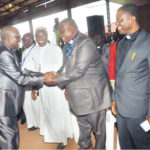The undying spirit of restructuring, bolstered by the adamant postures of Afenifere and Southern leaders, helped the restructuring agenda to manifest itself to this stage.
As things are right now, the entire country is talking restructuring one way or the other. The All Progressives Congress (APC), which promised devolution of Powers (a variant of restructuring) in 2015 but distanced itself from the idea thereafter, has changed its song and set up a committee that has embarked on nationwide tour to collate views on the restructuring agenda.
The North too has equally set up a Committee under the leadership of the Governor of Sokoto State, Hon. Aminu Waziri Tambuwal. The Middle-Belt, on Thursday, in Abuja, hosted Southern leaders to a meeting that adopted restructuring.
The inauguration of the Nasir El-Rufai and Tambuwal committees as well as the 2017 Yoruba Ibadan declaration, where the entire South and the Middle Belt converged, showed the desire of the countrymen to adopt the agenda and ever since, the idea has been winning more souls.
As things are now, we have retired the initial cliché –“restructuring means different things to different people” to a stage where everyone is engaging the issue.”
The meaning of restructuring could be varied and multifaceted but the overriding intent of the promoters is to reorganise the Nigerian polity towards a productive federation.
If every segment of the country is concerned the “feeding bottle federalism” of today is not working, it means we have got to do something to reverse the ugly trend. And the idea on the front burner is restructuring.
The fact is that the government at the centre appears to have become a behemoth, swallowing the functions of the other two layers of government. The Federal Government as we have it can dabble in almost every aspect of human endeavor. It could build primary, secondary as well as tertiary educational and health institutions. It controls the internal mechanisms and external relations. In short, you can say everything about Nigeria is the Federal Government. With 68 items on the Exclusive Legislative list, virtually everything on the table is at the purview of the Federal Government.
With the original promoters of restructuring still on the prowl and with the rate they are gaining more converts by the day, that should be good news, you would think. The National Assembly lawmakers who shot down the devolution of powers and Land Use Act Amendment bills in July have also started recanting with submissions of their readiness to revisit the issue.
Rather than jump for joy, however, this is the time for more work by proponents of restructuring. A Nigerian typical example that came to mind is the June 12 struggle. Activities of NADECO were at the peak in 1993, culminating in the stepping aside of General Ibrahim Babangida (rtd) as military president.
By the time General Sani Abacha took over from Ernest Shonekan-led Interim National Government in November 1993, there were reported handshakes between the hardline “on June we stand activists” and the anti-June 12 forces. There was relative peace on Abacha’s take over as a feeling the June 12 debacle would be settled took the air. At the end of the political drama, it became apparent that the June 12 advocates were merely sucked in just to enable the military a soft landing. Abacha went on to impose one of the most despotic regimes on the nation. So, my message of caution to the restructuring advocates is simple; watch your back as you gain converts across the Niger and Benue.
At this stage, I expect the promoters of restructuring to come up with workable options for a restructured Nigeria. Can we really return to regional structure of government? How do we merge the states that will not lead to rancour? Can we realistically merge the existing civil service structures? If we are retaining the states as they are, what level of regional control can we institute to ensure effectiveness? What would happen to the local government structure, which are the basis for creation of seats in the House of Representatives and the State Assemblies? Assuming we leave the existing states as federating units, what governance model do we adopt?
While I believe we need to restructure the Nigerian polity for effective and productive governance, I believe certain things are difficult to wean from the Federal level at this stage. We can have state police and community policing. We can institute fiscal federalism which would guarantee 50 percent derivation for all items, we shouldn’t have federal roads within states, but I believe it would be hard to restructure by merely exchanging functions between the Federal structure and the federating units or by only moving half or more of the 68 items on the Exclusive legislative list to the concurrent or residual lists.
Let’s take two examples, the Federal Government has invested in secondary education as well as owns the National Primary Healthcare Development Commission, which has offices in all states and most local governments. The staff members of these agencies are federal staff as it were; will they agree to a restructuring that will transfer them to states or local governments? My take is that we should restructure along the lines of 1963 Republican Constitution. There were 45 items on the Exclusive Legislative list at the time. Can we retain all that and return other functions to the States. Can we have timelines for the return of the “excess” items such that the State Civil Service would have been empowered to perform to expectation?
The complexity of the Nigerian setting would not allow a wholesale restructuring in one fell swoop. To avoid being sucked in for the kill, can the proponents itemize the immediate, medium and long term calendar for this agenda? That is the way to go.
Also Read:
Senate constitutional amendment: Explaining the four votes that failed
Senate constitutional amendment: Explaining the four votes that failed
WATCH TOP VIDEOS FROM NIGERIAN TRIBUNE TV
- Relationship Hangout: Public vs Private Proposals – Which Truly Wins in Love?
- “No” Is a Complete Sentence: Why You Should Stop Feeling Guilty
- Relationship Hangout: Friendship Talk 2025 – How to Be a Good Friend & Big Questions on Friendship
- Police Overpower Armed Robbers in Ibadan After Fierce Struggle






